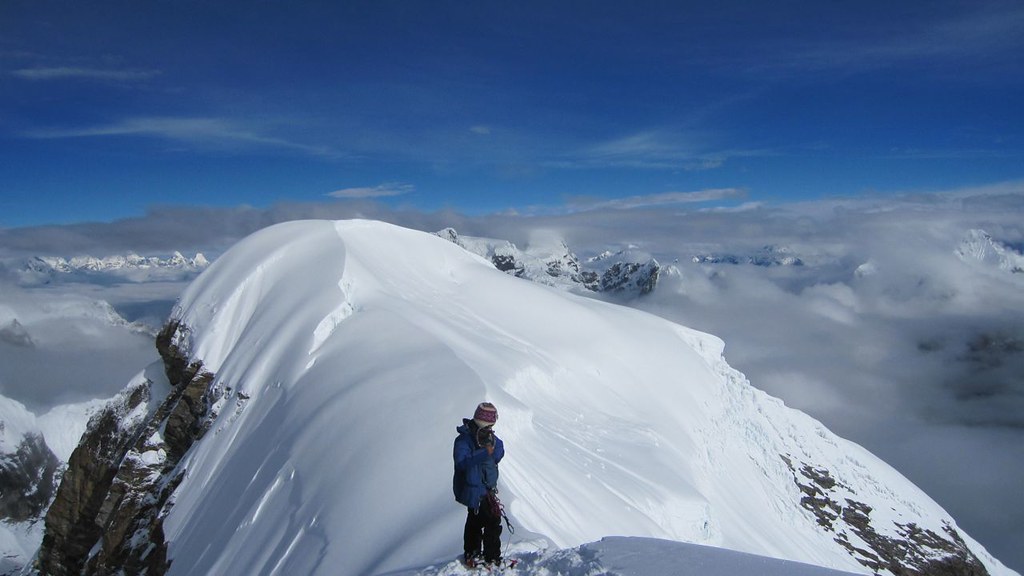
Trekking Peaks vs. Expedition Peaks: What’s the Difference?
Nepal, with its vast and varied mountainous terrain, has long been a magnet for adventurers seeking to conquer its peaks. Whether aspiring climbers are drawn to the allure of trekking peaks or the grandeur of expedition peaks, understanding the differences between the two is crucial for planning a safe and rewarding mountaineering experience. In this exploration, we delve into the distinctions between trekking peaks and expedition peaks, shedding light on the challenges, requirements, and unique experiences each category offers.
Understanding Trekking Peaks
Elevation and Difficulty:
Trekking peaks typically range in elevation from 5,500 meters (18,044 feet) to 6,500 meters (21,325 feet). These peaks are characterized by less technical climbing, making them accessible to individuals with basic mountaineering skills and a moderate level of fitness.
Permit Requirements:
Climbers tackling trekking peaks must obtain a climbing permit from the Nepal Mountaineering Association (NMA). The process involves submitting necessary documentation and adhering to regulations to ensure safety and responsible climbing practices.
Climbing Season:
Trekking peaks are often open for climbing during the popular trekking seasons of spring (April to June) and autumn (September to November). These periods provide stable weather conditions and clear visibility, enhancing the overall climbing experience.
Duration of Ascent:
The ascent of a trekking peak is generally shorter in duration, typically ranging from a few days to a couple of weeks. This makes trekking peaks ideal for individuals with time constraints or those looking to experience high-altitude climbing without a prolonged expedition commitment.
Prominent Examples of Trekking Peaks:
Island Peak (6,189 meters/20,305 feet)
Mera Peak (6,476 meters/21,247 feet)
Lobuche East (6,119 meters/20,075 feet)
Understanding Expedition Peaks
Elevation and Technical Difficulty:
Expedition peaks, also known as high-altitude or 8,000-meter peaks, exceed the 7,000-meter mark. These peaks demand advanced mountaineering skills, including proficiency in ice and rock climbing, as well as the ability to navigate challenging and technical terrain.
Permit Requirements:
Climbers attempting expedition peaks must secure permits from the Nepalese government and adhere to stringent regulations. The permitting process involves thorough scrutiny of the climbers’ experience, fitness levels, and overall preparedness for tackling the complexities of high-altitude climbs.
Climbing Season:
The climbing season for expedition peaks aligns with the spring and autumn periods, similar to trekking peaks. However, the window for climbing 8,000-meter peaks is narrow due to the extreme conditions at high altitudes.
Duration of Ascent:
Ascents of expedition peaks are significantly longer and more demanding, often spanning several weeks. Climbers must acclimatize to the high altitude, endure challenging weather conditions, and navigate through the various camps strategically established on the ascent route.
Prominent Examples of Expedition Peaks:
Mount Everest (8,848 meters/29,032 feet)
Kanchenjunga (8,586 meters/28,169 feet)
Lhotse (8,516 meters/27,940 feet)
Key Differences:
Altitude and Technicality:
The primary distinction lies in altitude and technical difficulty. Trekking peaks, while still high in elevation, are more accessible to climbers with basic mountaineering skills. Expedition peaks, on the other hand, demand advanced technical expertise and the ability to navigate complex and hazardous conditions.
Permitting and Regulations:
The permit requirements and regulations for trekking peaks are less stringent compared to expedition peaks. Climbers attempting expedition peaks undergo thorough scrutiny to ensure they possess the necessary skills and experience to tackle the challenges of high-altitude climbing.
Duration and Commitment:
The duration of ascent and overall commitment differ significantly between the two. Trekking peaks offer a relatively shorter and less time-consuming climbing experience, making them suitable for those seeking a high-altitude adventure without an extended time commitment. Expedition peaks, by contrast, demand a considerable time investment and unwavering commitment due to their challenging nature and extended durations.
Mera Peak Climbing: Bridging the Gap
Mera Peak, at 6,476 meters (21,247 feet), serves as a noteworthy example that blurs the lines between trekking and expedition peaks. While officially categorized as a trekking peak, Mera Peak’s elevation places it in the realm of higher altitudes. Climbers tackling Mera Peak experience a blend of both trekking and expedition characteristics, making it an excellent choice for those looking to bridge the gap between the two categories.
Mera Peak Climbing: A Unique Experience
Technical Challenge:
Mera Peak involves technical challenges, including ice climbing and glacier navigation. Climbers gain valuable high-altitude experience while enjoying the thrill of technical ascents.
Permitting Process:
Climbers obtain a permit from the NMA for Mera Peak Climbing. While less stringent than expedition permits, the process ensures a regulated and safe climbing experience.
Climbing Season:
Mera Peak shares a climbing season with both trekking and expedition peaks, offering flexibility for adventurers seeking a unique and well-rounded experience.
Duration of Ascent:
Mera Peak climbing typically spans around 15 days, striking a balance between the shorter duration of trekking peaks and the extended commitments of expedition peaks.
Conclusion: Choosing the Right Challenge
In the diverse and majestic mountain landscape of Nepal, the choice between trekking peaks and expedition peaks ultimately boils down to individual preferences, experience levels, and the desired level of challenge. Whether embarking on the ascent of a trekking peak, tackling the complexities of an expedition peak, or venturing into the unique realm of Mera Peak climbing, Nepal offers a spectrum of experiences that cater to every adventurer’s mountaineering aspirations. Understanding the differences between these categories ensures that climbers can choose the right challenge, fostering a safe, enjoyable, and fulfilling experience amidst the awe-inspiring Himalayan peaks.


